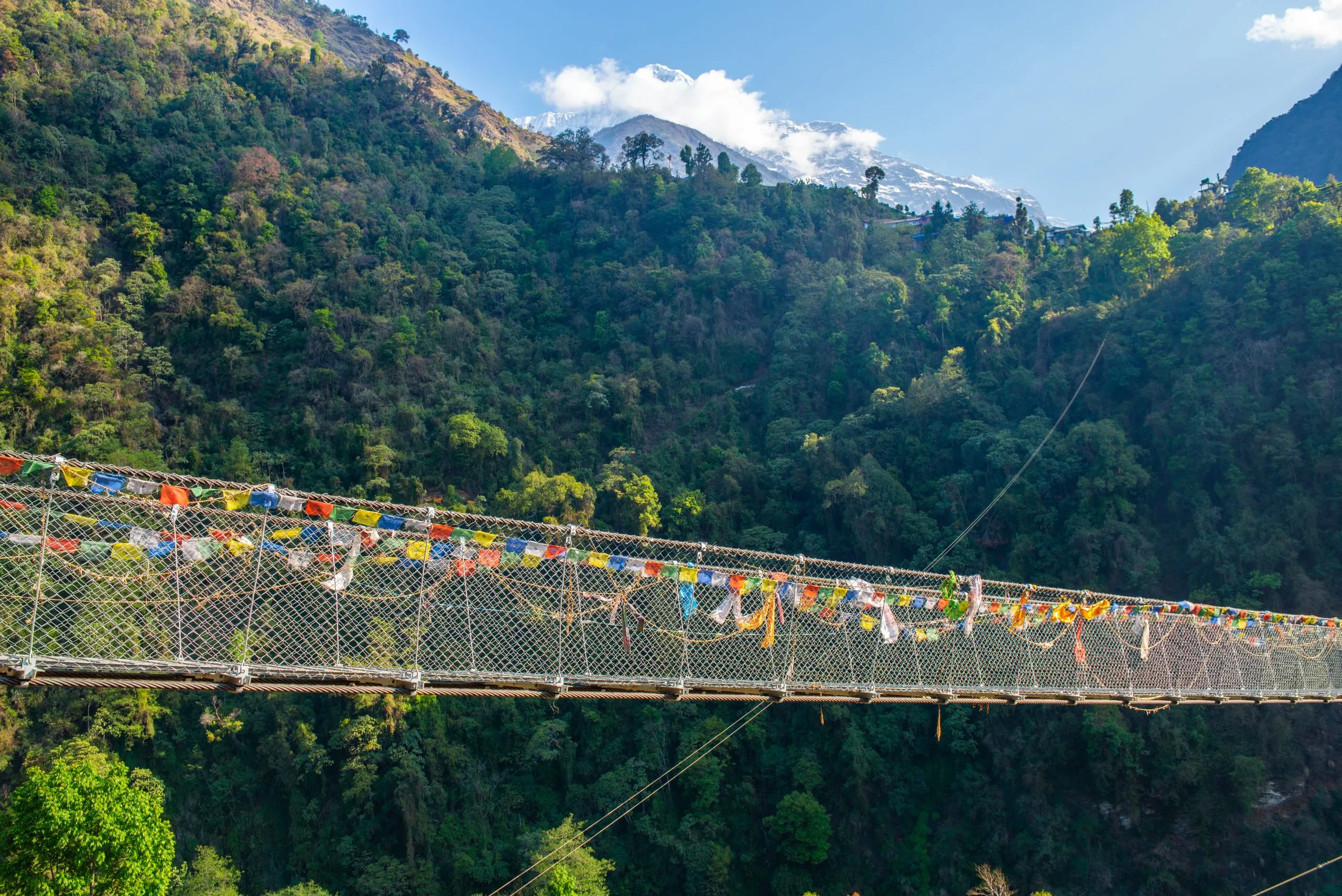The Annapurna Base Camp trek, also known as ABC or Annapurna Sanctuary Trek, is a renowned trekking destination nestled in the Annapurna region of Northwestern Nepal. Offering a unique blend of natural beauty, cultural richness, and adventure, this trek is a must-see for any outdoor enthusiast.
This comprehensive guide is designed to provide you with essential information to make your Annapurna Base Camp trek a memorable experience. From itineraries and fitness requirements to cultural insights and safety protocols, we’ve covered all aspects of the trek.
Whether you’re a seasoned trekker or embarking on your first Himalayan adventure, this guide equips you with the knowledge to navigate the trails, savor the breathtaking landscapes, and immerse yourself in Nepali culture.
By following this guide, you’ll be well-prepared for a journey that promises to be a highlight of your trekking career. Let’s dig in!
A brief overview of the trek in numbers
| Total Distance | 110 km |
| Total Ascent | 4,975 m/16,322 ft |
| Total Descent | 5,040 m/16,535 ft |
| Highest Point | 4,147 m/13,605 ft |
| Fitness Difficulty | 4/5 |
| Technical Difficulty | 2/5 |
| Duration | 10-13 days |
What is the Annapurna Base Camp?
Annapurna Base Camp, nestled in the heart of the Annapurna Conservation Area west of Pokhara, Nepal, is a captivating destination that has become a symbol of adventure and natural beauty. Sitting at an elevation of 4,130 m/13,547 ft, it offers panoramic views of the Annapurna massif and its surrounding peaks, including Annapurna I, Annapurna South, Machapuchare, and Hiunchuli.
One of the most popular trekking trails in Nepal, the journey to Annapurna Base Camp is as diverse as it is breathtaking. Trekkers traverse through dense rhododendron forests, cross deep rivers, and hike past terraced fields, all while being surrounded by towering mountain ranges. The trek also provides a unique opportunity to experience the rich cultural heritage of the local Gurung and Magar communities.
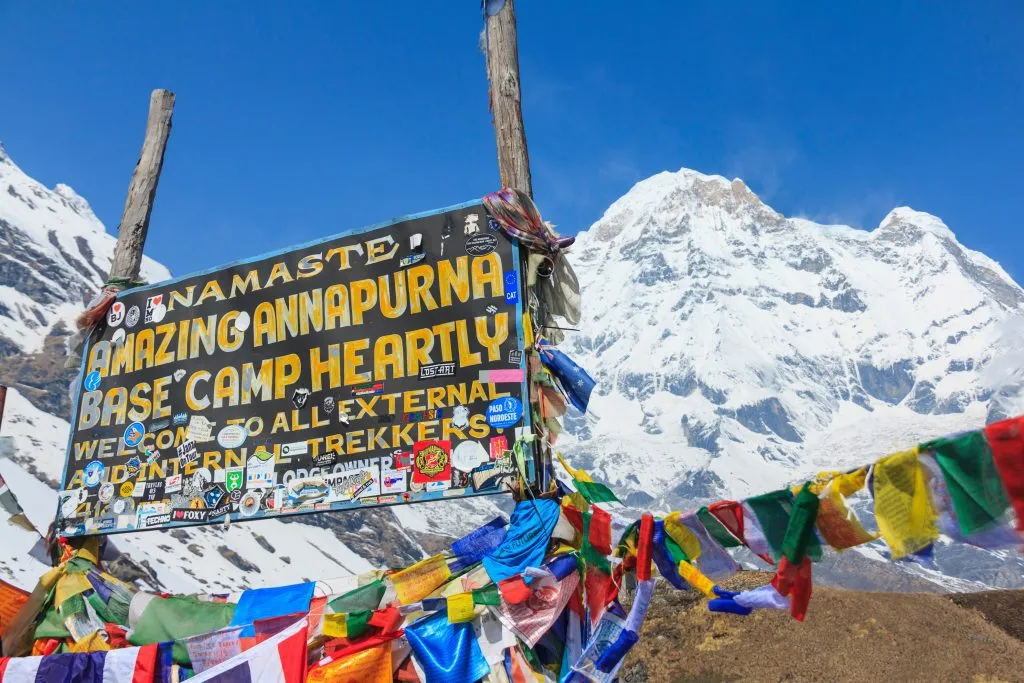
Historical and Cultural Significance
The Annapurna Base Camp Trek has a rich history that dates back to ancient times. Originally, the trek was used as a pilgrimage route to the Annapurna Sanctuary, a holy site for both Hindus and Buddhists. The sanctuary is home to several sacred temples, including the Annapurna Temple, dedicated to the goddess of food and nourishment.
Besides its religious significance, the trek was also used as a trade route between Nepal and Tibet. Many locals still use the trail to transport goods and supplies, reflecting the historical economic importance of the region.
Over time, the Annapurna Base Camp Trek has evolved from its humble beginnings as a pilgrimage route to one of the most popular and stunning treks in Nepal. It attracts thousands of adventure seekers from around the world each year, showcasing the evolution of trekking in the Annapurna Region.
The trekking experience in the Annapurna Base Camp has undergone significant changes over the years. What was once a grueling journey requiring months of preparation has become more accessible and comfortable, with well-established trails, accommodation options, and modern amenities.
With the growing popularity of the Annapurna Base Camp Trek, there have been concerted efforts to promote responsible tourism and sustainable development in the region. Initiatives to reduce waste, promote recycling, and protect local ecosystems are part of the ongoing commitment to preserve the cultural heritage and natural beauty of the area.
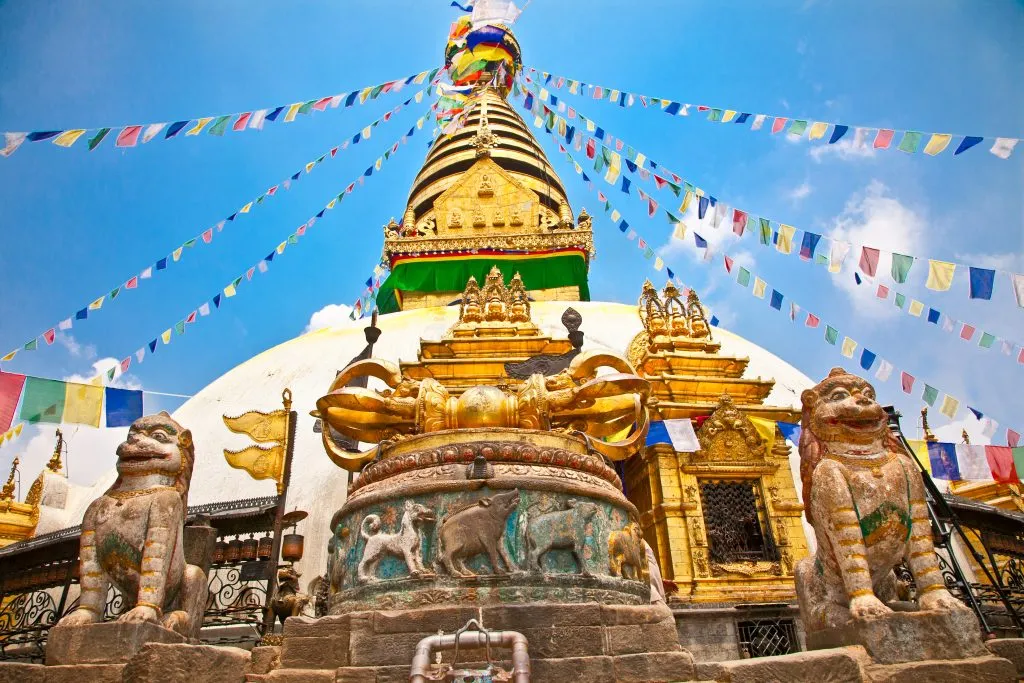
Highlights and Appeal of the Trek
Main highlights of the trek
- Trek to the Heart of the Annapurna Range: Experience the majestic Annapurna massif up close.
- Breathtaking Views of Iconic Peaks: Marvel at peaks like Annapurna I (8,091 m/26,545 ft), Machapuchare, and Hiunchuli.
- Cultural Immersion: Immerse yourself in the rich culture of Gurung and Magar villages.
- Natural Hot Springs: Relax in the natural hot springs of Jhinu Danda.
- Scenic and Diverse Trail: Follow the scenic trail along the Modi Khola, through lush forests, terraced fields, and waterfalls.
- Traditional Cuisines: Enjoy the traditional cuisines of Gurung and Magar ethnic groups.
- Spectacular Sunrise Views: Witness the fantastic view of sunrise over the snow-covered Annapurna mountain.
About the Destination
Nepal
Nepal, officially known as the Federal Democratic Republic of Nepal, is a landlocked country in South Asia that serves as a haven for nature enthusiasts and trekkers. With eight of the world’s ten highest mountains, including Mount Everest, Nepal’s mountainous north is a playground for adventurers. The country’s diverse geography ranges from the fertile and humid south to the towering peaks of the Himalayas, offering over 240 peaks more than 20,000 ft above sea level.
The trekking routes, such as the famous Annapurna Base Camp Trek, take you through lush rhododendron forests, terraced fields, and traditional villages, providing a glimpse into the rich culture and religions of the region.
Whether you’re seeking the thrill of conquering high-altitude trails or the serenity of nature’s embrace, Nepal’s landscapes provide an unparalleled experience that beckons explorers from around the world.
Kathmandu
Kathmandu, the capital city of Nepal, is often the starting point for many adventurers embarking on treks and expeditions in the Himalayas. Nestled in the bowl-shaped Kathmandu Valley, the city stands at an elevation of approximately 1,400 meters (4,600 ft) and is surrounded by major mountains like Shivapuri, Phulchoki, Nagarjun, and Chandragiri.
Known as the “City of Temples,” Kathmandu is rich in cultural heritage, with thousands of years of history reflected in its historic temples, monasteries, and cultural festivities.
As the gateway to tourism in Nepal, Kathmandu is the nerve center of the country’s economy, with tourism accounting for a significant portion of Nepal’s GDP. The city’s vibrant nightlife, musical talents, and rich cultural traditions make it a fascinating destination for tourists.
From exploring the UNESCO World Heritage Sites in the Kathmandu Valley to enjoying the local cuisine (don’t miss the MOMOs!), Kathmandu offers a blend of traditional charm and modern amenities.
Whether you’re staying for a day to recoup from jet lag or exploring the city’s many attractions, Kathmandu’s chaotic yet vibrant atmosphere is sure to leave an impression. It’s a city that welcomes foreigners with open arms and offers a glimpse into Nepal’s historical and traditional essence.

Trekking the ABC trek
When to go on the ABC trek?
The best season for the Annapurna Base Camp Trek is during spring and autumn, offering trekkers the most favorable weather conditions and majestic views of snowy peaks.
The spring season, which falls from March to May, is a time when wildflowers bloom, and the mountains are often visible from morning to late afternoon. It’s a season that brings comfortable temperatures and clear skies, making it a popular time for commercial mountaineering in Nepal.
Likewise, autumn, from late September to mid-November, is chosen by many trekkers for its crisp days and clear mountain views. The weather during this time is stable, and the remnants of the monsoon add extra beauty to the Himalayas.
While winter and monsoon treks are also possible, spring and autumn are generally recommended for the Annapurna Base Camp trek due to their more predictable and pleasant weather conditions.
Logistics – How to get there?
Getting to the Annapurna Base Camp Trek begins with a flight to Kathmandu, Nepal’s capital. Several international airlines operate flights to Kathmandu, including Malaysian Air, Qatar Airways, Fly Dubai, Air Arabia, Turkish Airlines, Thai Lion Air, and some Indian airlines like Air India and Vista Air from Delhi. If you’re traveling via Bangkok, Dubai, or Malaysia, you can connect with Nepal’s national carrier, Nepal Airlines (RA).
Once in Kathmandu, trekkers typically take a domestic flight or drive to Pokhara, a city located near the Annapurna region. From Pokhara, various transportation options are available to reach the starting point of the trek, such as local buses, taxis, or private vehicles.
Accommodation
Throughout the Annapurna Base Camp Trek, trekkers can find various teahouses and lodges for accommodation. These establishments offer basic amenities like beds, blankets, and meals. The quality of accommodations can range from simple and rustic lodges to more comfortable and well-furnished teahouses.
As you progress along the trek, the accommodation options may vary. In the lower regions, you may find teahouses with private rooms and attached bathrooms. However, as you ascend higher, the facilities become more basic, and you may have to share common bathrooms. Most teahouses provide a communal dining area, often with a central stove to keep warm.
Here’s a general idea of what to expect:
- Beds: Twin-sharing rooms with basic mattresses, pillows, and blankets.
- Bathrooms: Lower regions may offer attached bathrooms, while higher altitudes may have shared facilities. Hot showers may be available at an extra cost.
- Electricity and Charging: Electricity may be available but can be unreliable at higher altitudes. Charging devices might incur an additional fee.
- Wi-Fi: Some teahouses offer Wi-Fi, often at an extra cost, but the connection may be slow or unavailable in remote areas.
It’s advisable to carry a sleeping bag for extra warmth, especially during colder months. The accommodation experience along the Annapurna Base Camp Trek adds to the authentic mountain experience, allowing trekkers to immerse themselves in the local culture and hospitality.
Food
Food along the Annapurna Base Camp Trek is typically served in the teahouses and lodges where trekkers stay. The menu offers a mix of local Nepali dishes and international cuisine. Here’s what you can expect:
- Local Cuisine: The staple food is “Dal Bhat,” a traditional Nepali meal consisting of rice, lentil soup, vegetables, and pickles. It’s nutritious and often served in unlimited quantities.
- International Options: Many teahouses offer a variety of international dishes like pasta, pizza, pancakes, and more.
- Beverages: Tea, coffee, and soft drinks are widely available. Some places may offer local alcoholic beverages.
- Snacks: It’s advisable to carry some snacks like energy bars or dry fruits, as buying them on the trail can be expensive.
The food is freshly prepared, and vegetarian options are usually available. As you ascend higher, the menu may become more limited, and prices may increase due to the remote location.

Required Permits and Visas
Visa
All foreigners require a visa to enter Nepal. Visas are available on arrival at Kathmandu airport or any other entry point into Nepal. To obtain a visa, you must have a passport valid for at least six months. For more visa details, visit Nepali Immigration Portal.
On-Arrival Visa Fee:
- 15 Days – 30 USD
- 30 Days – 50 USD
- 90 Days – 125 USD
Permits
For the Annapurna Base Camp Trek, trekkers must obtain the following permits:
- Annapurna Conservation Area Project (ACAP) Permit: This permit is required to enter the Annapurna Conservation Area. The fee for foreigners is 3,000 NPR (Approx. 30 USD), and for SAARC nationals, it’s 200 NPR.
- Trekkers Information Management System (TIMS) Permit: This card is required for many treks in Nepal, including the Annapurna Base Camp Trek. The fee is 1,000 NPR (Approx. 10 USD).
Both permits can be obtained from the Nepal Tourism Board Office in Pradarshani Marg, Kathmandu, or from Pokhara’s TAAN Office located in Santi Patan. You’ll need to carry documents including your insurance policy number, information about your daily itinerary and route, a copy of your passport, and 2 passport-sized photos.
If your trip is being planned by a local agency, they will manage the permits for you.
The permits are non-transferable and non-refundable. An entry fee is not required for children under 10 years of age. Also, ensure that you carry both permits at all times and show them at the respective checkpoints.
Challenges of the ABC trek
The Annapurna Base Camp Trek is an incredible journey that offers breathtaking views and cultural experiences. However, like any high-altitude trek, it comes with its own set of challenges. Being aware of these challenges and preparing for them can make your trek more enjoyable and safe.
- Altitude sickness, or Acute Mountain Sickness (AMS), is a common challenge faced by trekkers at high altitudes. As you ascend, the air becomes thinner, and your body may struggle to adapt to the reduced oxygen levels. Symptoms include headaches, nausea, dizziness, and shortness of breath. To minimize the risk of AMS, it’s essential to acclimatize properly by ascending gradually and staying hydrated. Carrying altitude sickness medication like Diamox and consulting with a guide or medical professional if symptoms occur is also advisable.
- Stomach issues can be another challenge on the trek. Changes in diet, water contamination, or hygiene practices may lead to gastrointestinal problems. To avoid this, it’s recommended to eat freshly cooked food, avoid raw vegetables, and drink only treated or bottled water. Carrying anti-diarrheal medication and maintaining good personal hygiene can also help prevent stomach issues.
- Travel insurance is a critical aspect of planning your trek. Ensure that your insurance policy covers high-altitude trekking, emergency evacuation, and medical treatment in Nepal. Without proper insurance, medical and evacuation expenses can be outrageous. It’s wise to carefully review your policy and understand what is and isn’t covered.
- Understanding emergency and evacuation procedures is vital for your safety. In case of a serious injury or illness, immediate medical attention may be required. Helicopter evacuations are available but can be expensive. Knowing the nearest medical facilities, having a communication plan with your guide or trekking company, and carrying a basic first aid kit can be lifesaving. Your guide and local authorities will have protocols in place for emergencies, so make sure to follow their instructions.
Combining the itinerary with other treks nearby
Combining the Annapurna Base Camp Trek with other treks in the region can provide a more comprehensive and diverse trekking experience. Here’s an overview of how you can combine the itinerary with the Annapurna Circuit, Poon Hill, and Mardi Himal treks:
Combining with the Annapurna Circuit
The Annapurna Circuit is one of Nepal’s classic treks, encircling the Annapurna Massif. Combining the Annapurna Base Camp Trek with the Annapurna Circuit allows trekkers to explore both the inner sanctuary and the broader region. This combination offers a chance to experience diverse landscapes, from subtropical forests and terraced fields to alpine meadows and high deserts. It also provides an opportunity to traverse the Thorong La Pass, one of the highest trekking passes in the world.
Combining with Poon Hill
Poon Hill is renowned for its stunning sunrise views over the Annapurna and Dhaulagiri ranges. By adding Poon Hill to the Annapurna Base Camp Trek itinerary, trekkers can enjoy an additional viewpoint and explore the beautiful Ghorepani region. This combination is suitable for those looking to extend their trek by a few days and experience one of Nepal’s most famous sunrise spots.
Combining with Mardi Himal Trek
The Mardi Himal Trek is a lesser-known trail that offers a more off-the-beaten-path experience. Combining this trek with the Annapurna Base Camp Trek allows adventurers to explore the quieter parts of the Annapurna region. The Mardi Himal Trek provides stunning views of Machapuchare, Annapurna South, and Hiunchuli, along with a chance to trek through lush forests and traditional villages.
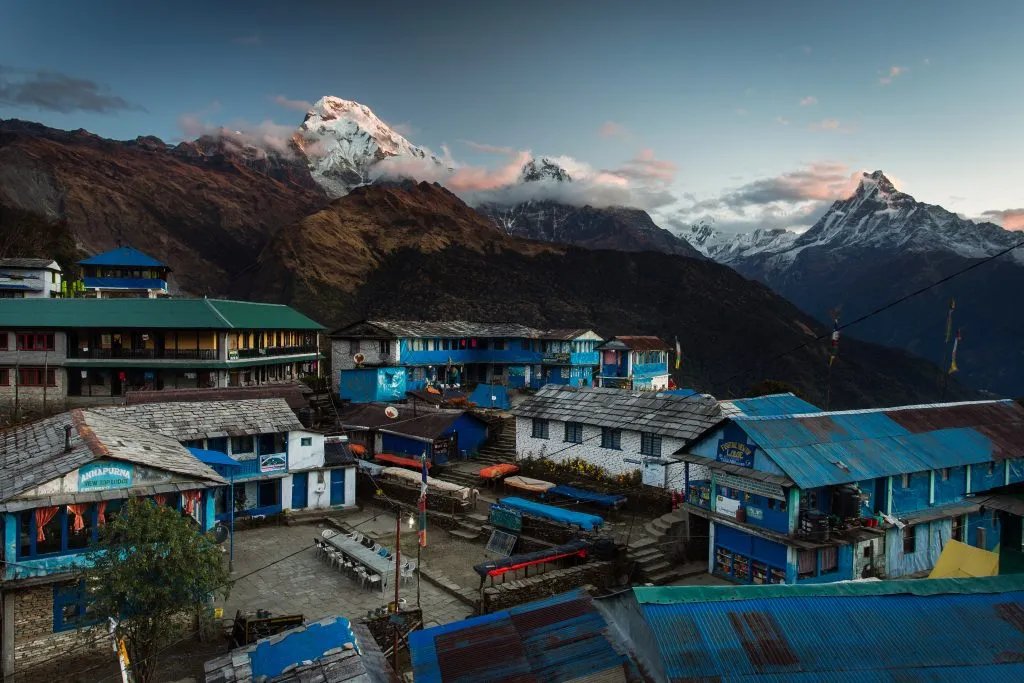
Options
The Nepalese government has introduced a new rule that requires all foreign hikers to be accompanied by a local guide while hiking in Nepal, with the exception of the Everest region. The Annapurna Base Camp falls under this initiative, so you are now required to hire a licensed local guide for this hike. Luckily, we are licensed guides in the region and can help you with that.
When planning the Annapurna Base Camp Trek, you have the option to trek with a licensed guide, with a porter, or both. Hiring a licensed guide offers expertise and knowledge of the local culture and geography, ensures safety, helps with navigation, and can provide a customized experience. Guides handle permits, accommodation, and other logistics, allowing you to focus on the trek itself.
Hiring a porter provides physical assistance by carrying your heavy backpack and equipment. Porters are often local residents who can provide a unique perspective on the region, and hiring them contributes to the local economy.
Many trekkers choose to hire both a licensed guide and a porter for the Annapurna Base Camp Trek. This combination offers comprehensive support, with expert guidance and physical assistance, enhancing the overall trekking experience. The choice between a licensed guide, a porter, or both depends on your preferences, budget, and the type of experience you seek.
As licensed guides in the region, we can assist you in finding the option that best suits your adventure, ensuring compliance with the new government regulations.
Cost of hiking the ABC trek
The cost of the Annapurna Base Camp Trek can vary widely depending on several factors such as the duration of the trek, whether you choose to hire a guide and/or porter, the level of accommodation, and the time of year.
On average, the cost may range from $900 to $1,200 for a typical 10 to 13-day trek. This usually includes permits, accommodation, meals, transportation to and from the trailhead, and guide or porter fees if applicable. Additional expenses may include personal gear, travel insurance, tips for guides and porters, and any extra activities or side trips. It’s advisable to consult with a licensed trekking agency to get a detailed and customized quote based on your specific needs and preferences.
How to prepare for the trek
Physical preparation
Physical preparation is a crucial aspect of getting ready for the Annapurna Base Camp Trek. Given the demanding nature of high-altitude trekking, building endurance and strength is essential. It’s advisable to start training at least two to three months before the trek.
Incorporate regular cardiovascular exercises like running, cycling, or swimming to improve stamina. Hiking on varied terrains, preferably with a loaded backpack, can simulate the conditions of the trek and help your body adapt. Strength training focusing on legs, core, and back muscles will enhance your ability to carry a pack and navigate challenging trails.
Flexibility exercises like stretching and yoga can also be beneficial. If possible, spending time at higher altitudes before the trek can aid in acclimatization.
Packing and gear
Packing the right gear is essential for a successful and enjoyable Annapurna Base Camp Trek. Here’s a comprehensive packing list to guide you:
Hiking Gear:
- Day bag
- Walking poles
- Water bottle
- Headlight
Clothes:
- Down jacket
- Sleeping bag
- Light warm hiking trousers
- Warm liner
- Towel
- Warm and sun hats
- Fleece/jacket and pants
- Windproof jacket
- Long and half sleeve hiking shirt
- Buff for neck and head
- Hiking boots
- Gloves/mittens
- Warm hiking socks (wool/synthetic)
- Sandals
Sun Protection, Health Hygiene, and Water:
- Sun cream
- Sunglasses
- Sun hat
- Lip guard
- Toothbrush
- Face wash soap
- Sanitizer
- Prescription medicine
- Water purifier tablet/lightweight filter
- Toilet paper
- Menstrual products
Personal Belonging Items:
- Passport
- Cash
- Visa/credit card
- Cell phone Power bank charger
- Camera/GoPro
Remember, the weather in the Annapurna region can be unpredictable, so packing layers and waterproof items is wise. Proper packing will contribute to a more comfortable and enjoyable trekking experience.
Final Tips & Recommendations
Embarking on the Annapurna Base Camp Trek is an unforgettable adventure that requires careful planning and consideration. From physical preparation and packing the right gear to understanding the challenges and choosing the best trekking options, every detail contributes to a successful journey.
Remember to respect local customs and the environment, stay hydrated, and follow the guidance of your licensed guide. Whether it’s the breathtaking views, the rich cultural experiences, or the personal achievement, the Annapurna Base Camp Trek offers rewards that are well worth the effort.
These tips and recommendations encapsulate the essence of the trek, helping you to embark on a well-prepared and fulfilling Himalayan experience.
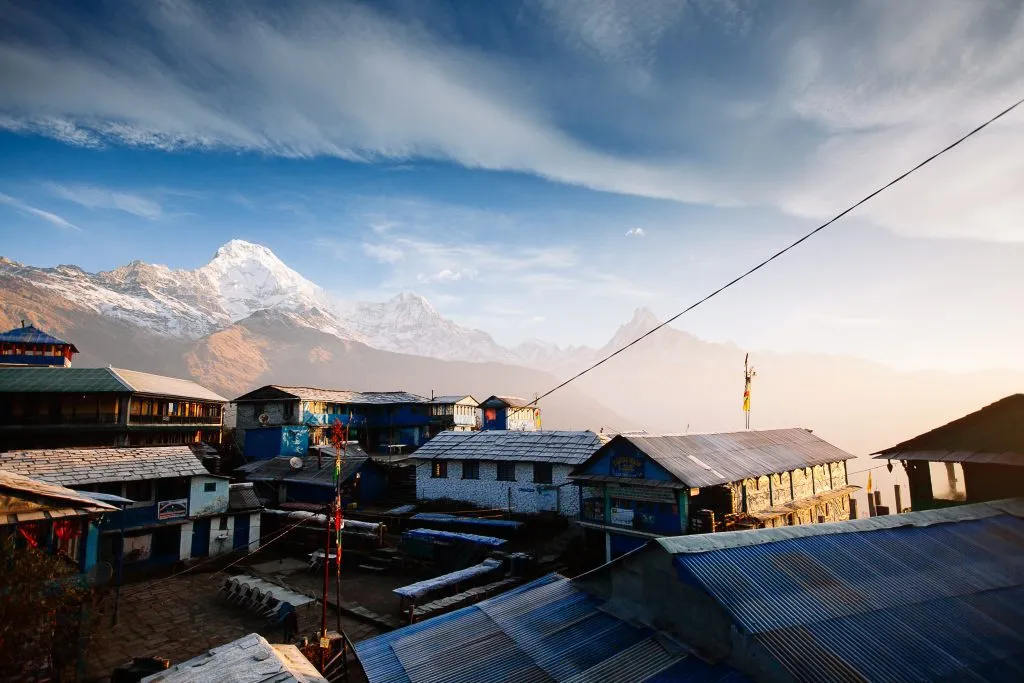
Why join an organized expedition?
Embarking on the Annapurna Base Camp Trek is a journey filled with discovery, adventure, and personal fulfillment. With the requirement for an organized expedition, having experienced guides to lead the way ensures a seamless and enriching experience.
If you’re intrigued by the beauty and challenge of the Annapurna region and wish to explore further, you might find our curated trekking program aligned with your adventure aspirations.
Feel free to explore what we offer, and perhaps we’ll have the pleasure of accompanying you on this incredible Himalayan journey. Happy trekking!


